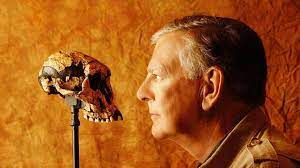On November 24, 1974, paleoanthropologist Donald Johanson and his team found the most complete early human skeleton (Lucy, Australopithecus afarensis) ever discovered in history in the Middles Awash of the Afar Depression near Hadar, Ethiopia.
This extraordinary skeleton included 47 of the normal 207 bones, an amazingly high percentage, considering it was buried some 3.2 million years ago. Parts of arms, legs, pelvis, and spine were gathered by the team.
In celebration, a recording of the Beatles “Lucy in the Sky with Diamonds” was played. Lucy got her name from that song.
While Johanson was exploring the region, he happened upon some bones sticking out of the ground. He was stunned when he realized they weren’t the bones of some animal but of a hominid. Careful excavation by the team revealed the rest of the hidden paleontological treasure.
The large collection of bones allowed the team to determine Lucy’s height, weight, gait, diet, mode of life, and cause of death.
Lucy stood about 3.5 feet tall, weighed in at 64 pounds, walked upright, ate plants, slept in a tree nest, and died from a fall from a tree. Some cracks in her arm looked like they were caused by a fall instead of erosion.
What did scientists learn about our ancient ancestors from studying Lucy’s skeleton? For one thing, her brain was small, roughly the size of a modern chimpanzee’s. For another, our ancestors began walking upright far earlier than anyone had guessed.

